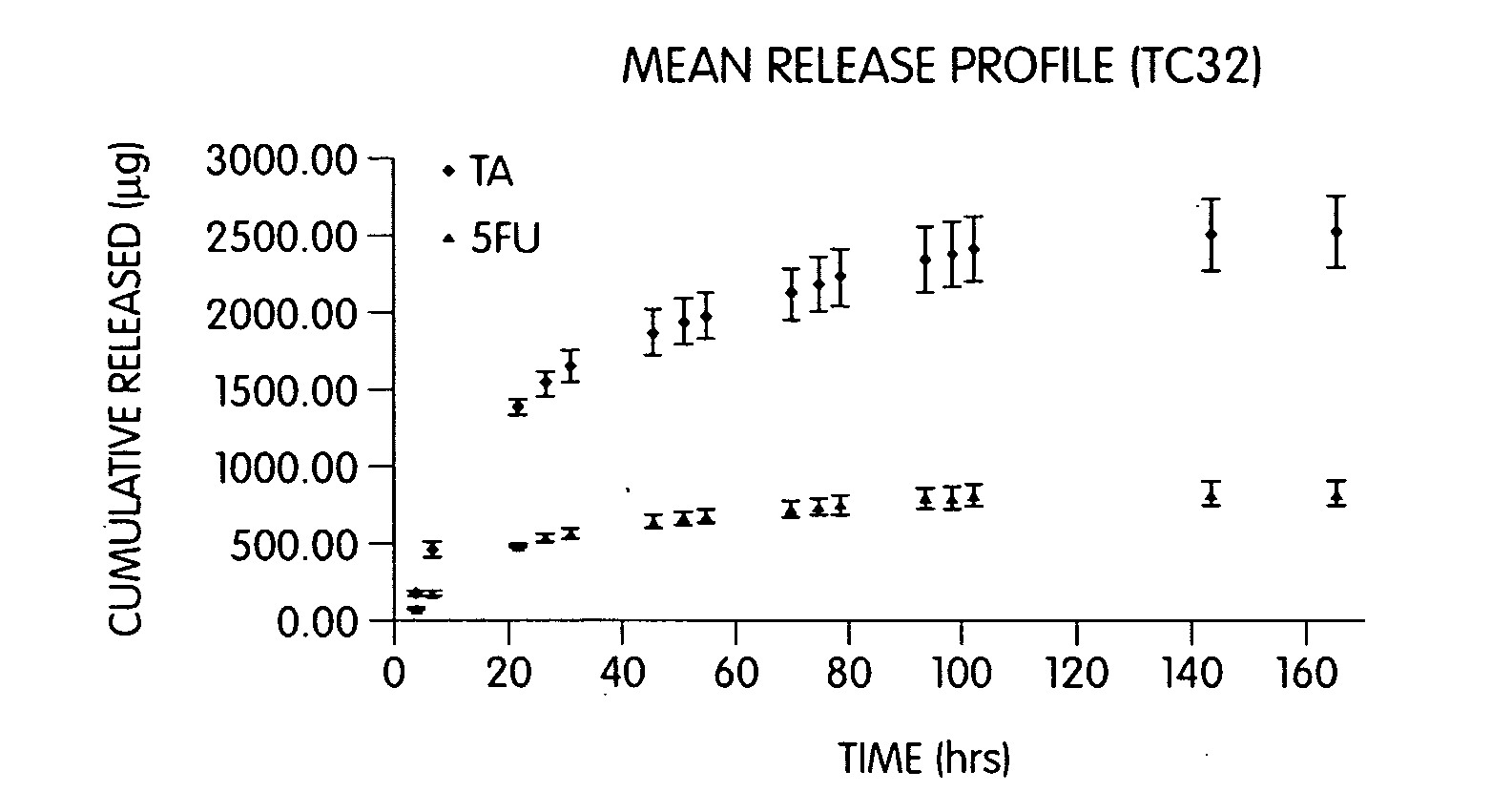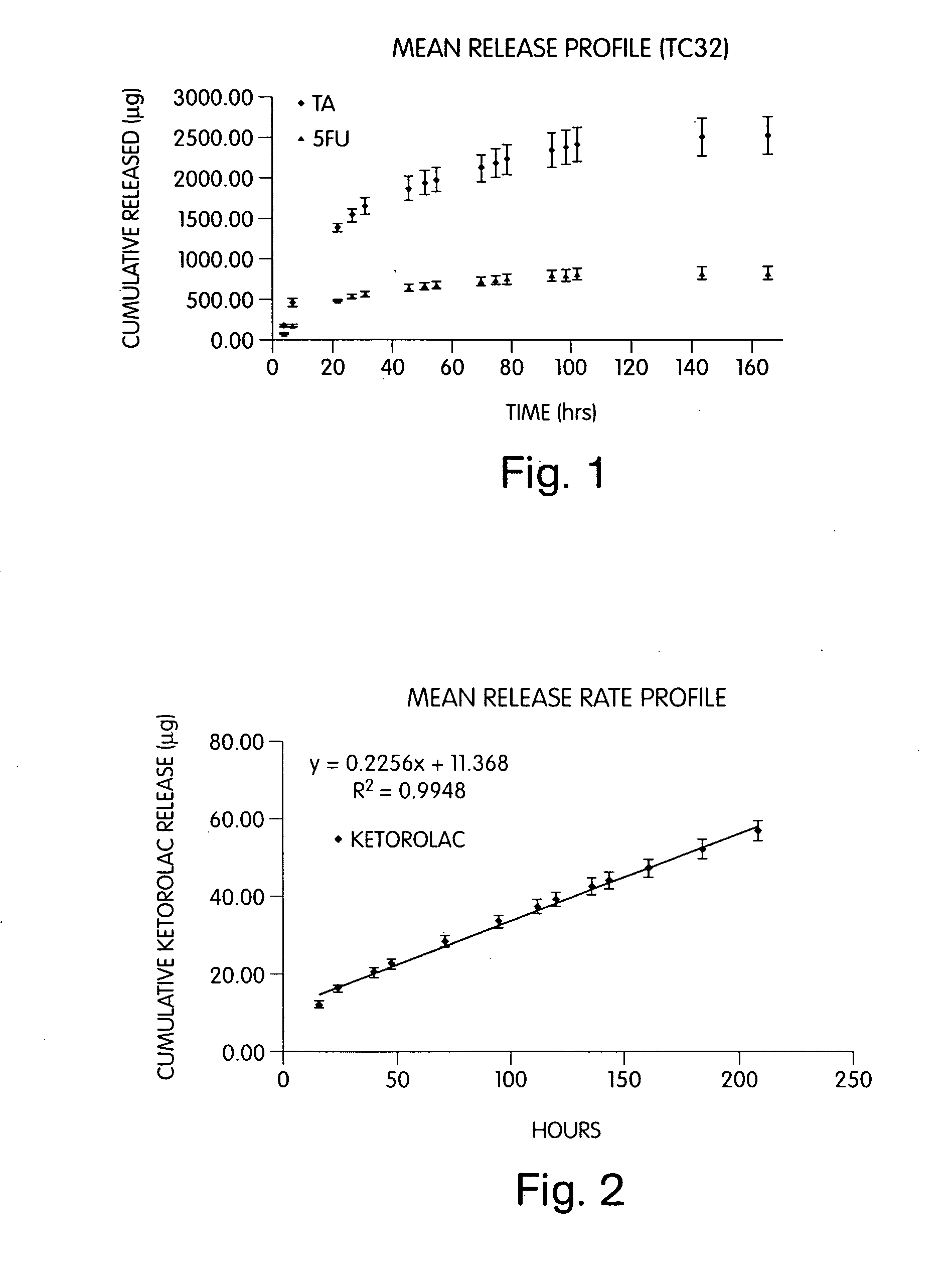Polymeric gel delivery system for pharmaceuticals
a polymer gel and drug technology, applied in the direction of drug compositions, immunological disorders, metabolism disorders, etc., can solve the problems of inefficient drug delivery, inability to meet the needs of patients, so as to increase the rate of drug release and increase the rate of drug hydration
- Summary
- Abstract
- Description
- Claims
- Application Information
AI Technical Summary
Benefits of technology
Problems solved by technology
Method used
Image
Examples
example 1
[0237]Sodium hyaluronate (900 mg) was combined with TC-32 (codrug of triamcinolone acetonide and 5-fluorouracil, 108 mg) and magnesium stearate (5 mg) to form a blend. Tablets of 50 mg mass and 4.5 mm diameter were hand compressed using the blend. Each tablet was then placed in a dialysis tube containing 0.5 ml of 0.1 M phosphate buffer at pH 7.4. The release study was commenced by placing each sealed dialysis tube in 100 ml of 0.1 M phosphate buffer, pH 7.4 (dialysate) at 37° C. Samples of the dialysate were taken periodically by partially or entirely replacing the dialysate with fresh buffer. The amount of TC-32 or its hydrolysis by-products (TA and 5-FU) released into the dialysate was determined by quantitative HPLC.
example 2
[0238]Sodium hyaluronate (200 mg) was combined with sodium alginate (80 mg), CaHPO4 (80 mg), TC-32 (40 mg), and magnesium stearate (2.0 mg) to form a blend. Tablets of 50 mg mass and 4.5 mm diameter were hand compressed. Each tablet was then placed in a dialysis tube containing 1.0 ml of 0.1 M phosphate buffer, pH 7.4. The release study was commenced by placing each sealed dialysis tube in 100 ml of 0.1 M phosphate buffer, pH 7.4 (dialysate) at 37° C. The amount of TC-32 or its hydrolysis by-products (TA and 5-FU) released into the dialysate was determined by quantitative HPLC (see FIG. 1).
example 3
[0239]Sodium hyaluronate (350 mg) was combined with CaHPO4 (150 mg), TC-32 (50 mg), and magnesium stearate (2.5 mg) and mixed to form a blend. Tablets of 50 mg mass, 4.5 mm diameter, were hand compressed using the blend. Each tablet was then placed in a dialysis tube containing 1.0 ml of 0.1 M phosphate buffer, pH 7.4. The release study was commenced by placing each sealed dialysis tube in 100 ml of 0.1 M phosphate buffer, pH 7.4 (dialysate) at 37° C. Samples were taken periodically by partially or entirely replacing the dialysate with fresh buffer. The amount of TC-32 released into the dialysate was determined by quantitative HPLC.
PUM
| Property | Measurement | Unit |
|---|---|---|
| wt. % | aaaaa | aaaaa |
| wt. % | aaaaa | aaaaa |
| diameter | aaaaa | aaaaa |
Abstract
Description
Claims
Application Information
 Login to View More
Login to View More - R&D
- Intellectual Property
- Life Sciences
- Materials
- Tech Scout
- Unparalleled Data Quality
- Higher Quality Content
- 60% Fewer Hallucinations
Browse by: Latest US Patents, China's latest patents, Technical Efficacy Thesaurus, Application Domain, Technology Topic, Popular Technical Reports.
© 2025 PatSnap. All rights reserved.Legal|Privacy policy|Modern Slavery Act Transparency Statement|Sitemap|About US| Contact US: help@patsnap.com



